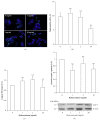Excess Hydrocortisone Hampers Placental Nutrient Uptake Disrupting Cellular Metabolism
- PMID: 30402483
- PMCID: PMC6198558
- DOI: 10.1155/2018/5106174
Excess Hydrocortisone Hampers Placental Nutrient Uptake Disrupting Cellular Metabolism
Abstract
Low birth weight increases neonatal morbidity and mortality, and surviving infants have increased risk of metabolic and cardiovascular disturbances later in life, as well as other neurological, psychiatric, and immune complications. A gestational excess of glucocorticoids (GCs) is a well-known cause for fetal growth retardation, but the biological basis for this association remains elusive. Placental growth is closely related to fetal growth. The placenta is the main regulator of nutrient transport to the fetus, resulting from the difference between placental nutrient uptake and the placenta's own metabolism. The aim of this study was to analyze how excess hydrocortisone affects placental glucose and lipid metabolism. Human placenta explants from term physiological pregnancies were cultured for 18 hours under different hydrocortisone concentrations (2.75, 5.5, and 55 mM; 1, 2, and 20 mg/ml). Placental glucose and lipid uptake and the metabolic partitioning of fatty acids were quantified by isotopic techniques, and expression of specific glucose transporter GLUT1 was quantified by western blot. Cell viability was assessed by MTT, immunohistochemistry and caspase activity. We found that excess hydrocortisone impairs glucose uptake and lipoprotein lipase (LPL) activity, coincident with a GC-dose dependent inhibition of fatty acid oxidation and esterification. None of the experimental conditions showed an increased cell death. In conclusion, our results show that GC overexposure exerts a dysfunctional effect on lipid transport and metabolism and glucose uptake in human placental explants. These findings could well be directly related to a reduced placental growth and possibly to a reduced supply of nutrients to the fetus and the consequent fetal growth retardation and metabolic programming.
Figures






Similar articles
-
The effect of high glucose on lipid metabolism in the human placenta.Sci Rep. 2019 Oct 1;9(1):14114. doi: 10.1038/s41598-019-50626-x. Sci Rep. 2019. PMID: 31575970 Free PMC article.
-
Brief hyperglycaemia in the early pregnant rat increases fetal weight at term by stimulating placental growth and affecting placental nutrient transport.J Physiol. 2007 Jun 15;581(Pt 3):1323-32. doi: 10.1113/jphysiol.2007.131185. Epub 2007 Apr 12. J Physiol. 2007. PMID: 17430988 Free PMC article.
-
Hepatocyte growth factor is elevated in amniotic fluid from obese women and regulates placental glucose and fatty acid metabolism.Placenta. 2015 Apr;36(4):381-8. doi: 10.1016/j.placenta.2015.01.199. Epub 2015 Feb 7. Placenta. 2015. PMID: 25690371
-
Placental regulation of fetal nutrient supply.Curr Opin Clin Nutr Metab Care. 2013 May;16(3):292-7. doi: 10.1097/MCO.0b013e32835e3674. Curr Opin Clin Nutr Metab Care. 2013. PMID: 23416721 Review.
-
Placental transport of nutrients and its implications for fetal growth.J Reprod Fertil Suppl. 1999;54:401-10. J Reprod Fertil Suppl. 1999. PMID: 10692871 Review.
Cited by
-
Impact of Glucocorticoids on Cardiovascular System-The Yin Yang Effect.J Pers Med. 2022 Nov 3;12(11):1829. doi: 10.3390/jpm12111829. J Pers Med. 2022. PMID: 36579545 Free PMC article. Review.
-
Fetomaternal Expression of Glucose Transporters (GLUTs)-Biochemical, Cellular and Clinical Aspects.Nutrients. 2022 May 12;14(10):2025. doi: 10.3390/nu14102025. Nutrients. 2022. PMID: 35631166 Free PMC article. Review.
-
Prenatal Exposure to High Cortisol Induces ADHD-like Behaviors with Delay in Spatial Cognitive Functions during the Post-weaning Period in Rats.Exp Neurobiol. 2021 Feb 28;30(1):87-100. doi: 10.5607/en20057. Exp Neurobiol. 2021. PMID: 33632985 Free PMC article.
-
Role of Placental Glucose Transporters in Determining Fetal Growth.Reprod Sci. 2022 Oct;29(10):2744-2759. doi: 10.1007/s43032-021-00699-9. Epub 2021 Aug 2. Reprod Sci. 2022. PMID: 34339038 Review.

